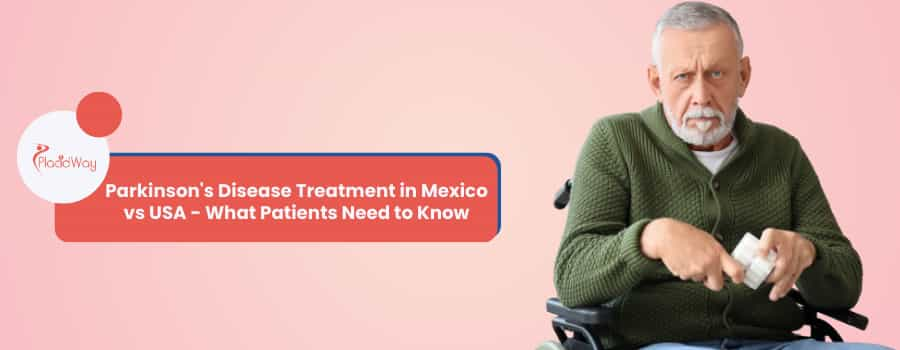
Living with Parkinson's Disease presents a unique set of challenges, often requiring long-term care, specialized medications, and sometimes advanced surgical interventions. For many patients and their families, the choice of where to seek treatment involves a complex balance of medical quality, cost, accessibility, and continuity of care. This comprehensive guide delves into the nuances of Parkinson's disease treatment in Mexico versus the USA, offering clear, actionable insights for those navigating this critical decision. Whether you're considering Deep Brain Stimulation (DBS) surgery in Mexico or exploring ongoing neurological care in the USA, we aim to equip you with the knowledge to make an informed choice for your health journey.
Navigating Parkinson's Care: Mexico vs. USA Explained
Parkinson's Disease (PD) is a progressive neurological disorder affecting millions worldwide. While there is currently no cure, effective treatments can significantly manage symptoms and improve quality of life. Patients often seek the best possible care, which can lead them to explore options beyond their immediate vicinity.
The United States is renowned for its cutting-edge medical research, advanced technology, and a high concentration of movement disorder specialists. However, the associated costs can be prohibitive, especially for complex procedures like Deep Brain Stimulation (DBS) surgery and long-term medication management. This financial burden often prompts patients to look for more affordable Parkinson's treatment options.
Mexico has emerged as a prominent destination for medical tourism, attracting patients from the US and Canada primarily due to its competitive pricing and proximity. Many Mexican clinics offer high-quality neurological care in Mexico, with experienced doctors, modern facilities, and streamlined processes for international patients. Understanding the strengths and weaknesses of each country's healthcare system in the context of Parkinson's treatment is essential for making a decision that aligns with both medical needs and financial realities.
Parkinson's Disease Treatment: Mexico vs. USA at a Glance
Deep Dive into Parkinson's Care: Core Strengths
USA Key Capabilities in Parkinson's Treatment
The United States stands at the forefront of neurological research and treatment. Its key strengths include:
- Pioneering Research & Clinical Trials: Access to the latest experimental treatments, drug developments, and cutting-edge surgical techniques like advanced forms of DBS or focused ultrasound. Many academic medical centers are global leaders in PD research.
- Comprehensive Multidisciplinary Care: A holistic approach involving neurologists, neurosurgeons, physical therapists, occupational therapists, speech therapists, nutritionists, and psychologists, all under one roof or closely coordinated.
- Strict Regulatory Oversight: High standards of quality and patient safety enforced by organizations like the FDA and state medical boards, providing a robust framework for ethical and effective care.
- Advanced Technology & Infrastructure: State-of-the-art diagnostic imaging, surgical equipment, and rehabilitation facilities.
- Specialized Movement Disorder Centers: Dedicated centers of excellence that focus solely on conditions like Parkinson's, offering unparalleled expertise and resources.
Mexico Key Capabilities in Parkinson's Treatment
Mexico's medical tourism sector has grown significantly, offering compelling advantages for Parkinson's patients:
- Cost-Effectiveness: The most significant draw, with treatments like DBS surgery Mexico price being a fraction of US costs, making advanced care accessible to those without extensive insurance coverage.
- Accessibility & Proximity: Convenient for North American patients, involving shorter travel times and easier logistics than other international destinations. Many clinics are located in border cities or popular tourist hubs.
- Experienced Specialists: A growing number of neurologists and neurosurgeons trained internationally, offering expertise in movement disorders and DBS procedures.
- Modern Facilities: Many private hospitals catering to international patients boast modern infrastructure, advanced equipment, and comfortable amenities comparable to US facilities. Some hold international accreditations like JCI.
- Reduced Waiting Times: Patients can often schedule procedures and consultations much faster than in the US, avoiding long waits for essential treatments.
Parkinson's Treatment in the USA - Pros and Cons
Pros of USA Parkinson's Care
- Unrivaled Expertise: Access to world-renowned neurologists, neurosurgeons, and movement disorder specialists who are pioneers in the field.
- Cutting-Edge Innovation: First access to new drugs, therapies, and surgical techniques often developed through extensive research in US institutions.
- Comprehensive Support Network: Robust patient advocacy groups, support organizations, and integrated care pathways for long-term management and rehabilitation.
- Insurance Coverage: For eligible patients, private insurance, Medicare, or Medicaid can significantly offset the high costs of treatment.
- Seamless Follow-up: Easy access to follow-up appointments, medication adjustments, and DBS device programming with the original medical team or a local specialist.
Cons of USA Parkinson's Care
- Exorbitant Costs: Without adequate insurance, procedures like DBS surgery and ongoing medication can be financially crippling, leading to significant out-of-pocket expenses.
- Insurance Hurdles: Navigating complex insurance policies, pre-approvals, and coverage limitations can be stressful and time-consuming.
- Potential Waiting Lists: For highly sought-after specialists or specific procedures at leading centers, waiting times can be substantial.
- Geographic Disparity: Access to top specialists and advanced centers may require travel, especially for patients in rural areas.
Parkinson's Treatment in Mexico - Pros and Cons
Pros of Mexico Parkinson's Care
- Significant Cost Savings: Major procedures and medications are substantially more affordable, making advanced care accessible to a broader range of patients, particularly those uninsured or underinsured in the US.
- Reduced Waiting Times: Often quicker access to consultations and procedures, minimizing the progression of symptoms while waiting for treatment.
- Geographic Convenience: For North American patients, Mexico is an easily accessible destination, reducing travel burden and associated costs.
- Personalized Care: Some clinics offer a more personalized, patient-centric approach with dedicated patient coordinators to assist international visitors.
- Modern Facilities: Many private hospitals catering to medical tourists are well-equipped with state-of-the-art technology and comfortable patient environments.
Cons of Mexico Parkinson's Care
- Variable Quality: While many clinics are excellent, the quality of care can vary widely. Thorough vetting is essential to ensure you choose a reputable and qualified facility.
- Regulatory Differences: The regulatory environment is different from the USA, which can lead to concerns about oversight and patient recourse in some cases.
- Limited Clinical Trials: Fewer opportunities to participate in cutting-edge research or access experimental therapies.
- Follow-up Challenges: Long-term post-operative care, especially for DBS programming, may require additional travel or careful coordination with a local neurologist.
- Language and Cultural Barriers: While major clinics offer English-speaking staff, navigating logistics outside the hospital may present challenges for non-Spanish speakers.
Beyond DBS: Medication and Supportive Care
Parkinson's treatment extends far beyond surgical interventions. Medication management is a cornerstone of care for most patients, often involving drugs like Levodopa, dopamine agonists, and MAO-B inhibitors. In the USA, Parkinson's medication costs can be very high, even with insurance, pushing many to generic alternatives or patient assistance programs. In Mexico, Parkinson's medication is generally more affordable, and common generics are widely available. Patients often find significant savings on their monthly prescriptions.
Supportive therapies, including physical therapy, occupational therapy, and speech therapy, are also crucial for maintaining function and improving quality of life. The USA boasts a highly developed infrastructure for these therapies, often integrated into comprehensive care plans. While Mexico's offerings may be less standardized, many private clinics and rehabilitation centers provide excellent services. Patients must ensure continuity of these therapies regardless of where they receive primary medical treatment.
Psychological support, nutritional guidance, and access to support groups are further aspects of holistic Parkinson's care. Both countries offer these resources, but their accessibility and integration into medical treatment plans can differ. US clinics often have dedicated social workers and psychologists, while in Mexico, patients might need to seek these services independently or through patient advocacy groups.
Making Your Decision: Key Factors for Parkinson's Treatment
The decision between seeking Parkinson's treatment in Mexico or the USA is deeply personal and multifaceted. Consider the following factors:
- Financial Situation & Insurance: If cost is the primary concern and US insurance coverage is limited or non-existent, Mexico offers a compelling alternative for advanced treatments.
- Severity and Stage of Parkinson's: For early-stage disease primarily managed with medication, local US care might be sufficient. For advanced stages requiring DBS, the cost savings in Mexico can be substantial.
- Importance of Continuity of Care: If seamless long-term follow-up with a single medical team is critical, the USA's integrated systems might be preferable. However, a well-planned strategy for follow-up can bridge this gap for Mexican treatments.
- Access to Clinical Trials: If participation in cutting-edge research is a priority, the USA offers significantly more opportunities.
- Travel Comfort & Logistics: Your ability and willingness to travel, handle potential language barriers, and navigate a foreign healthcare system should be assessed.
- Accreditation and Reputation: Regardless of location, always prioritize clinics with international accreditations (e.g., JCI) and strong patient testimonials, ensuring high standards of care for Parkinson's care travel Mexico or within the USA.
Both countries offer viable pathways for managing Parkinson's Disease. The key is to weigh these factors against your personal priorities, medical needs, and financial capabilities.
Real Stories from Patients
John L., California, USA
"After years of struggling with medication management and the sheer cost of US care for my Parkinson's, I decided to explore DBS surgery in Mexico. The clinic in Tijuana was state-of-the-art, and the team was incredibly professional. I saved over $70,000, and my symptoms are significantly better. The follow-up coordination was excellent."
Maria G., Arizona, USA
"My husband's Parkinson's progressed rapidly, and we couldn't wait months for DBS here in the US. A friend recommended a highly-rated clinic in Monterrey, Mexico. The entire process was efficient, the doctors were fantastic, and we felt truly cared for. It was the best decision for his quality of life and our peace of mind."
Sarah T., New York, USA
"While the costs for my Parkinson's treatment in the US are high, my insurance coverage is robust, and the access to specialists at a leading academic hospital here is unparalleled. I appreciate being able to participate in clinical trials and the integrated care from my entire medical team."
Robert K., Texas, USA
"I decided on a well-known Parkinson's clinic in San Diego for my treatment because I valued the consistent, local follow-up care. Although the deep brain stimulation USA cost was higher, having my doctors nearby for adjustments and concerns made a huge difference to me."
Frequently Asked Questions About Parkinson's Disease Treatment
Is Parkinson's disease treatment in Mexico safe and effective?
Many clinics in Mexico offer high-quality Parkinson's disease treatment, including advanced procedures like Deep Brain Stimulation (DBS). Safety and effectiveness depend on selecting a reputable, accredited clinic with experienced neurologists and surgeons. Thorough research and vetting are crucial.
How much cheaper is Parkinson's treatment in Mexico compared to the USA?
The cost of Parkinson's disease treatment, especially procedures like DBS surgery, can be significantly lower in Mexico, often ranging from 50% to 70% less than in the USA. This includes the procedure, hospital stay, and sometimes post-operative care, though medication costs might vary.
What are the main differences in Deep Brain Stimulation (DBS) surgery between Mexico and the USA?
In the USA, DBS is widely available in specialized centers with extensive research and post-operative support. In Mexico, DBS is offered at select advanced clinics, often at a lower cost, but it's vital to ensure the clinic has a dedicated multidisciplinary team and robust follow-up protocols comparable to US standards.
Are Parkinson's medications available and affordable in Mexico?
Yes, common Parkinson's medications are available in Mexico, and they are generally more affordable than in the USA, especially when purchased without insurance. However, patients should confirm the availability of specific brands or generic equivalents with their chosen clinic.
How do I choose a reputable clinic for Parkinson's treatment in Mexico?
Look for clinics with international accreditations (e.g., JCI), experienced neurologists and neurosurgeons specializing in movement disorders, clear success rates for their procedures, transparent pricing, and robust patient testimonials. Utilizing a medical tourism facilitator like PlacidWay can also help.
Will my US insurance cover Parkinson's treatment in Mexico?
Generally, most US health insurance plans do not cover medical treatments received outside the United States, except in emergency situations. Some rare exceptions or specialized medical tourism insurance might exist, but it's crucial to verify directly with your provider.
What kind of post-operative care and follow-up can I expect after DBS surgery in Mexico?
Reputable Mexican clinics should offer comprehensive post-operative care, including initial device programming and follow-up consultations. It's essential to plan for long-term follow-up, which might involve returning to Mexico or coordinating with a neurologist in your home country for ongoing programming and medication management.
What is the typical waiting time for Parkinson's treatment in Mexico versus the USA?
Waiting times for specialized Parkinson's treatments, particularly DBS surgery, can often be shorter in Mexico due to lower patient volumes and different healthcare system structures. In the USA, waiting lists can sometimes be longer, especially for top specialists or specific procedures, due to high demand and insurance pre-approvals.
Are there language barriers for English-speaking patients seeking treatment in Mexico?
Many prominent medical tourism clinics in Mexico employ English-speaking staff, including doctors, nurses, and patient coordinators, to facilitate communication for international patients. While basic Spanish can be helpful outside the clinic, it's not typically a barrier for receiving medical care at top facilities.
How does the legal framework for medical procedures differ between Mexico and the USA?
The USA has a highly regulated medical environment with strict oversight from bodies like the FDA and state medical boards. Mexico also has its own regulatory bodies (e.g., COFEPRIS), but standards and enforcement can vary. It's important for patients to understand the legal protections available in both countries.
Ready to Explore Your Parkinson's Treatment Options?
Making the right choice for Parkinson's Disease treatment is a significant step towards a better quality of life. This guide provides a detailed overview, but your unique medical history, financial situation, and personal preferences demand a tailored approach. At PlacidWay, we specialize in connecting patients with pre-vetted, world-class Parkinson's treatment clinics in Mexico and can help you navigate options in the USA as well.
Our dedicated Care Team is here to provide a free, no-obligation consultation. Let us assist you in comparing personalized treatment packages, understanding transparent pricing for Parkinson's treatment cost in Mexico, and answering all your specific questions. Empower your decision-making process with expert guidance and support.
















Share this listing